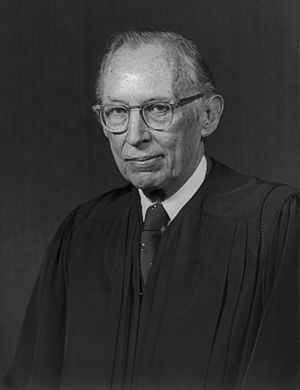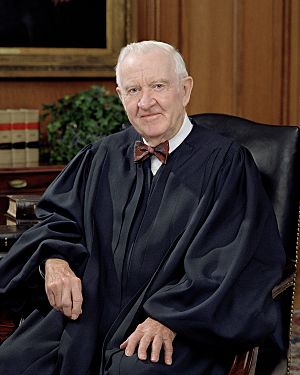County of Oneida v. Oneida Indian Nation of New York State facts for kids
Quick facts for kids County of Oneida v. Oneida Indian Nation of New York State |
|
|---|---|

|
|
| Argued October 1, 1984 Decided March 4, 1985 |
|
| Full case name | County of Oneida, New York, et al. v. Oneida Indian Nation of New York State, et al. |
| Citations | 470 U.S. 226 (more)
105 S. Ct. 1245, 84 L. Ed. 2d 169, 53 U.S.L.W. 4225
|
| Prior history | 464 F.2d 916 (2d Cir. 1972), cert. granted, 412 U.S. 927 (1973), rev'd, Oneida Indian Nation of New York v. County of Oneida, 414 U.S. 661 (1974), on remand, 434 F. Supp. 527 (N.D.N.Y. 1977), aff'd, 719 F.2d 525 (2d Cir. 1983), cert. granted, 465 U.S. 1099 (1984). |
| Subsequent history | Rehearing denied, 471 U.S. 1062 (1985), on remand, 217 F. Supp. 2d 292 (N.D.N.Y. 2002), motion for relief denied, 214 F.R.D. 83 (N.D.N.Y. 2003), motion for relief granted after remand, 2003 WL 21026573 (N.D.N.Y. 2003). |
| Holding | |
| Indian tribes have a federal common law cause of action, not preempted by the Nonintercourse Act, for possessory claims based upon aboriginal title; such action is not barred by limitations, abatement, ratification or nonjusticiability, and due to the Eleventh Amendment, there is no ancillary jurisdiction for counties' cross-claims against a state. | |
| Court membership | |
| Case opinions | |
| Majority | Powell, joined by Blackmun, O'Connor (Parts I, II, III, IV, VI joined by Brennan, Marshall; Part V joined by Burger, White, Rehnquist) |
| Concur/dissent | Brennan, joined by Marshall |
| Concur/dissent | Stevens, joined by Burger, White, Rehnquist |
| Laws applied | |
| U.S. Const. amend. XI; Federal common law; Nonintercourse Act | |
County of Oneida v. Oneida Indian Nation of New York State, 470 U.S. 226 (1985), was a very important case decided by the Supreme Court of the United States in 1985. It focused on the land rights of Native American tribes, especially their original ownership of land, known as aboriginal title. This case is often called Oneida II. It was the first time an Indian land claim was won based on the Nonintercourse Act.
The Supreme Court decided that Native American tribes have a right to sue in court for land claims based on their original ownership. This right comes from "federal common law," which means it's based on past court decisions, not a specific law passed by Congress. The Court also said that the Nonintercourse Act did not stop these lawsuits. They also ruled that these lawsuits could not be stopped because too much time had passed (a "statute of limitations") or for other reasons like "laches" (delay in bringing a claim).
However, the Court also said that federal courts could not hear claims by counties against states. This was because of the Eleventh Amendment, which limits when states can be sued in federal court.
This case is known as Oneida II because it was the second time the Oneida Indian Nation went to the Supreme Court to fight for their land rights. The first case, Oneida Indian Nation of New York v. County of Oneida (1974), decided that federal courts had the power to hear the case. A later case, City of Sherrill v. Oneida Indian Nation of New York (2005), dealt with the tribe trying to get back control over land they had bought.
What Led to the Case?
This was the second time the Supreme Court looked at the Oneida's land claim. More than ten years earlier, in Oneida Indian Nation of New York v. County of Oneida (1974), the Supreme Court had allowed the same lawsuit to go forward. They decided that federal courts had the power to hear the case.
After that first decision, the case went back to a lower court, the United States District Court for the Northern District of New York. This court found that the counties had wrongly held the Oneida's land. It ordered the counties to pay damages, which was money for the fair rent of the land for two years. The court also said that New York state had to pay back the counties for these damages. A higher court, the United States Court of Appeals for the Second Circuit, agreed with these decisions.
The Supreme Court decided to hear the case again to figure out if a Native American tribe could still sue for land rights from 175 years ago. The Court ultimately agreed with the lower courts that the tribe could. The counties did not argue that the Oneida didn't originally own the land. They also didn't argue that the land sales to the state in 1795 broke the Nonintercourse Act. Instead, the counties argued that the lawsuit should be stopped for other reasons.
Court's Decision
Justice Lewis F. Powell, Jr. wrote the main opinion for the Supreme Court. He agreed that the Oneida tribe had the right to sue for their land. He also rejected all the reasons the counties gave to stop the lawsuit.
Right to Sue
The Supreme Court said that the Oneida tribe had a "federal common law cause of action." This means they had a right to sue based on long-standing legal traditions and past court decisions. The Court noted that many past decisions had already recognized this right for Native American tribes.
The counties had argued that the Nonintercourse Act should prevent the lawsuit. But the Court said the Act didn't stop the tribe from suing. The Act didn't say how to fix problems when land was sold illegally. The Court found that Congress didn't intend for the Act to take away the tribes' right to sue.
Time Limits on Lawsuits

Usually, there are time limits, called "statutes of limitations," for bringing lawsuits. If there isn't a federal time limit, courts sometimes use state time limits. However, the Supreme Court said that using a state time limit in this case would go against federal policy. They looked at how Congress had dealt with Native American land claims in the past. The Court decided that it would be wrong to use a state time limit here.
Delay in Bringing a Claim (Laches)
Some of the justices who disagreed with the main decision thought the Oneida's claim should be stopped because of "laches." This is a legal idea that says if someone waits too long to bring a claim, and that delay harms the other side, the claim might be blocked.
However, the majority of the Court did not decide on this issue. They noted that the lower court had already ruled against the counties on this point. The majority also said that applying "laches" to a case about land ownership from so long ago would be unusual. They felt it would go against federal policy for Native American rights.
Other Arguments from the Counties
The counties made other arguments to stop the lawsuit:
- Abatement: They argued that earlier versions of the Nonintercourse Act expired, and so did the right to sue. The Court disagreed, saying that the different versions of the Act were similar enough that the right to sue continued.
- Ratification: The counties claimed that later treaties between the Oneidas and the U.S. government meant the earlier land sales were approved. The Court rejected this. They said that treaties with Native Americans should be understood in a way that favors the tribes.
- Nonjusticiability: The counties argued that the land claim was a "political question" that courts shouldn't decide. The Court disagreed, saying that similar Native American land cases had been decided by courts before.
Claims Against the State
The final question was whether the lower court was right to allow the counties to sue the state of New York for repayment. The Court said no. They explained that the Eleventh Amendment prevents federal courts from hearing lawsuits against states in this situation.
Court's Final Thoughts
The Court ended by saying that this case showed how important it was for Congress to act. They felt Congress should pass laws to help resolve these old Native American land claims. The Court noted that it seemed strange that claims from over 150 years ago could still be active. But they found no legal reason to stop the Oneida's claims.
Justices Brennan and Marshall's View
Justices William J. Brennan, Jr. and Thurgood Marshall agreed with most of the main opinion. However, they disagreed with the part about the Eleventh Amendment. Justice Brennan believed the Eleventh Amendment only stopped lawsuits against states by citizens of other states, not by their own citizens.
Justices Stevens, Burger, White, and Rehnquist's View

Justice John Paul Stevens, joined by Chief Justice Warren E. Burger and Justices Byron White and William Rehnquist, agreed with the part of the decision that stopped the counties from suing the state. But they disagreed with the main decision that allowed the Oneida's claim against the counties.
These justices believed the Oneida's claim should have been stopped because of "laches," the idea that too much time had passed. They pointed out that the Oneidas waited 175 years to sue over a land sale from 1795. They felt that such a long delay, especially when there was no trickery involved, should prevent the lawsuit. They said that society needs land titles to be secure. They believed the Court was trying to fix a past wrong but was causing a new problem that only Congress could fix.
What Happened After the Case?
Back to the Lower Court
After the Supreme Court's decision, the case went back to the lower court. After many years of trying to reach a settlement, the judge ordered Oneida County and Madison County to pay damages to the Oneida Nation. This money covered the fair rental value of the land, plus interest.
Related Cases
- Oneida Indian Nation of New York v. New York (1988): Another Oneida land claim, about a different large piece of land, was rejected by a court in 1988. The court said that a rule from 1783 did not have the power to limit land sales within states.
- City of Sherrill v. Oneida Indian Nation of New York (2005): After many years, the Oneida Nation started buying back land within their original claim area. They said they were sovereign (had independent control) over these lands and refused to pay property taxes. In this 2005 case, the Supreme Court decided that the tribe could not suddenly re-assert sovereignty over these lands because of "laches" (too much time had passed). The Court did not change its earlier decision in Oneida II that the original land claim was valid.
- Oneida Indian Nation of New York v. County of Oneida (2010): The Oneida I and Oneida II cases were like test cases. The Oneidas had a larger lawsuit against the counties for 200 years of damages, which was paused. This larger lawsuit started again in 2000. In a similar case involving another tribe, a court used the "laches" argument that the dissenting justices in Oneida II had used. This "laches" defense also defeated the Oneida's larger claim for damages. The Supreme Court later refused to hear an appeal on this decision.

